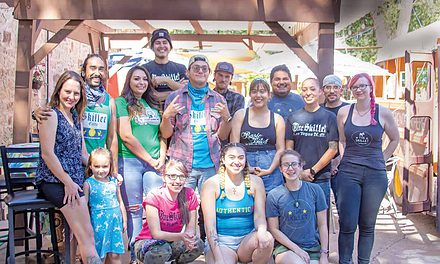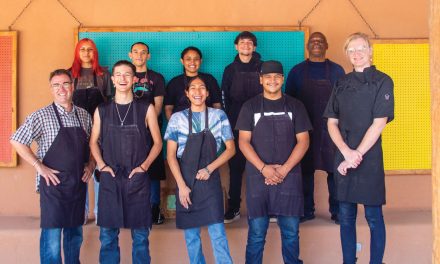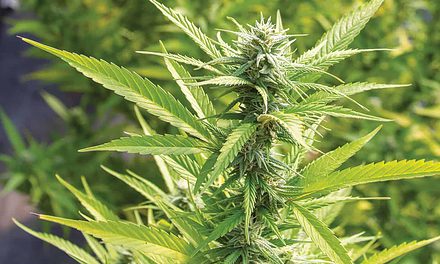The exchange that occurs between Lloyd Kreitzer and his figs is somewhat remarkable. In fact, you could say their relationship is symbiotic.
Kreitzer, otherwise known as the Fig-Man of Albuquerque, propagates fig trees. He assists them with the gift of life and renewal. In exchange, the figs share with Kreitzer their sweet fruit and wisdom of the ages. “What do figs want to teach me? They see life as an adventure. There are two possibilities: life and death. They are interested in accommodating. The fig teaches generosity and patience and wants to make people feel good.”
Kreitzer, too, wants to make people feel good. And so he teaches, preaches and shares the magic of the fig tree with anyone who is interested. During market season, when he’s not also making people feel good as a Feldenkrais practitioner, it’s easy to find him selling fig trees at numerous Albuquerque-area growers’ markets. He also teaches fig propagation workshops and is willing to mentor people interested in the art of “figging.” Even in the middle of winter, his Albuquerque greenhouse is teeming with 87 varieties of fig trees along with a plethora of other heirloom tree stock such as Chinese date, plum, pomegranate, grape, carob, and olive.
But figs are what truly get Kreitzer salivating. “I don’t know what it is, if it is the contrast between the dry poppy seed interior and the rich, emollient flesh that opens up a pleasure center in the brain, but figs elicit a dimensional response,” he says with the passion of one who spent much time musing over the compelling nature of the fig.
Kreitzer remembers the moment his fascination began. He was four years old and climbed into his uncle’s ripe fig tree in Santa Monica. It was love at first bite. Though it was many years before he came back to figs, he has a theory about this. “All of us are like dogs who bury our favorite bones so we can have them again later in life. Our bones are our dreams and loves. And figs were my buried bone from 50 years ago that came up and bit me in the butt.”
Though only 10% of Americans have ever tasted a fresh fig according to Kreitzer, figs have captivated humans for an extremely long time. According to an article published in the June 2, 2006 issue of Science magazine, researchers at Bar-Ilan University in Israel reported evidence of parthenocopic (unfertilized) figs at six sites in the greater Mediterranean Sea region dating between 11,700 and 10,500 years ago. By way of reference, this evidence of domesticated fruit occurs at roughly the same time as rice domestication in Asia, but fully five thousand years earlier than millet or wheat or any other seed plant in the middle east.
To understand how scientists know these ancient figs were domesticated and not just a wild species of fruit gets to the heart of their strange and fascinating biology. It also underscores the ecological mutualism that exists between Kreitzer and his plants.
In short, fig trees (Ficus carica) come in two types: hermaphrodite and female, and while each plays a different role, both are dependent for propagation on another creature—either a fig wasp to pollinate it, or a human to cut a branch and root it. If a fig does not have a wasp embryo within it, it has been propagated by humans. This is why the Israeli archeologists who found the 11,400-year-old figs without wasp remnants believe the early fig trees were domesticated and not just a wild species.
Although the precise number of fig varieties remains elusive (500 is common estimate), the larger Ficus genus includes more than 2,000 species worldwide. Some of the most well known figs are black mission, brown turkey and white adriatic, and they can be green, yellow or dark colored. So what does the fig have that has kept humans interested in them for thousands of years? Kreitzer might say it’s because they are beautiful, sacred, and sweet. Proselytizing on behalf of figs is easy for him at growers’ markets, where he can catch unsuspecting shoppers and fig fanatics alike. One taste and he is ready to assist them with fig answers of all kinds, including how to grow these deciduous trees in New Mexico.
Fortunately, these trees with their unique, deeply lobed, finger-like leaves are very flexible, and can grow anywhere in New Mexico—Santa Fe, Albuquerque, Deming, Taos, Los Alamos, and beyond. Kreitzer says the most important time to keep your eye on them is in winter and during the last few spring frosts. He recommends insulating them with chicken wire hoops filled with leaves, pine needles and straw when they are young during the winter months, or if you live where temperatures fall below 12 degrees F, planting them in a container so it can be brought indoors when the temperature dips. Kreitzer suggests a 15-gallon plastic container, since they hold moisture better and are lighter to move than ceramic.
Fig trees love eight or more hours of sunshine and the heat helps ripen their fruit. While every tree will need a fair amount of water in its first years, once fig trees are established they are not only drought tolerant, but also low water users, probably due to their extensive and wide-ranging root system. Kreitzer says the trees don’t mind our alkaline clay or sandy soils, though it tends to keep the trees small, usually less than 11 feet high compared to the 15-30 feet they may grow elsewhere. He says it’s best to think of them as fig bushes.
How long will you need to wait for fruit? According to Kreitzer, a oneyear old fig tree can produce fruit, but some trees may take an additional year. Some varieties produce fruit once a year in late July through September, while other varieties will fruit twice a season, once in late July and again in September. Kreitzer says fig trees will often be the last plant to leaf or fig in the spring, so you shouldn’t be surprised if a month (or several) passes before they suddenly leaf out.
While fig trees are extremely hardy, the fruit is delicate and must be handled with care. They must be picked when completely ripe, and can’t be kept very long in cold storage before spoiling. The description of how you will know if a fig is ripe is a bit morbid, but Kreitzer says that when the fig looks like a hanged man, “the neck is long and bent, the skin is wrinkled, and there is a tear at the eye (the eye is the little hole at the bottom of the fig),” you will know it is ripe and ready to be eaten.
While Kreitzer provides loads more advice on how and where to plant your tree, and the kinds of compost and manure to feed it, the most difficult decision, he says, is choosing a variety. Location may dictate some of the choices, but in the end, Kreitzer says he tells customers to choose a plant that pleases them esthetically. “Maybe it’s the shape of the leaves, or the color of a bud, or knowing that one variety fruits twice per season, but in the end, people should observe what plant speaks to them,” he says.
One of Kreitzer’s gifts is his power of observation. Does a tree need more water or less, an old blanket to provide shade or some pine needles for insulation? Listening to Kreitzer talk about what he learns from his beloved figs is remarkably reminiscent of the way Michael Pollan describes his approach to observing our relationship with nature from the plant’s point of view in the forward of his book, “The Botany of Desire—A Plant’s Eye View of the World.” Kreitzer, like Pollan, sees the interconnectedness between human desires and the natural world. “I think that life wants to speak from anyplace that we put our intelligence,” he says. “It’s where you put your focus that your wisdom will come from. I always ask what do the figs want to teach me?”
Whether you are interested in learning patience, flexibility or simply want to enjoy the delicious and healthy fruit of one of the oldest cultivars known to man, figs embrace an astonishing array of possibilities. “Each aspect of who we are has a time and a season in our lives,” says Kreitzer. Clearly this is the season for the Fig-Man of Albuquerque.
Figs: A Healthy, Culinary Delight
Figs are a nutritious snack right off the tree and delicious when used in prepared foods. Fresh figs make simple, yet elegant, desserts or hors d’oeuvres, and dried figs are great on a cheese platter.
Both fresh and dried figs can be used as nutritious snacks and in desserts such as fig tarts or fig bars. Figs can be grilled or slightly warmed and stuffed with a soft cheese such as mascarpone, ricotta, or farmer’s. Try a drizzle of honey or a thick and sweet balsamic vinegar reduction and a garnish of honey-roasted walnuts to top them off.
Figs are also delicious in homemade jam and in savory dishes such as fresh fig-stuffed pork loin with fennel and onions. Fig leaves are edible; they can be used to wrap around foods and cooked similar to grape leaves. Kreitzer also sells fig leaf tea that is helpful for balancing blood sugar.
Figs are considered a functional food; they have health benefits beyond the nutrition they offer. Figs contain phenols, which are antioxidants that may help with weight loss and help to protect against cancer and heart disease. Of all the common fruits, figs are the highest in overall mineral content and are an excellent source of both soluble and insoluble fiber.
For more information, visit the Fig-Man of Albuquerque at www.landofenfigment.com







